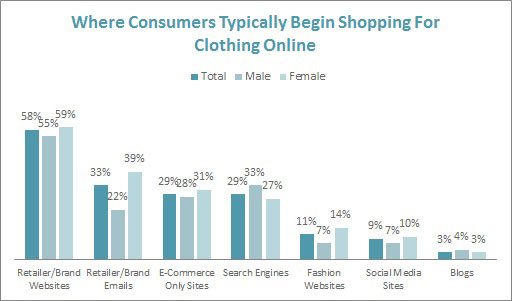Today, retail is all about engagement: learning what the consumer wants, while promoting products and messages – often without a selling mentality. And it is making everyone more social.
McKinsey’s Nora Aufreiter, senior partner in marketing and sales, and retail practices, says social media remains largely about discovery and advocacy versus transaction.
“Almost three quarters of consumers rely on social networks to guide purchase decisions, and photo-based interfaces like Pinterest, Tumblr, etc., have really driven engagement,” Aufreiter says, saying reports show significant increases in traffic and conversion when products are posted on these sites. “Social will continue to play a role in commerce, just not how it was first imagined.”
Almost 10% of consumers say they start shopping for apparel online using social media websites, up significantly from 3% in 2010, according to the Cotton Incorporated Lifestyle Monitor™ Survey. Additionally, among consumers who read customer reviews when shopping for clothes online, nearly a fifth (17%) read them on social sites.
To that end, ModCloth is covering its bases with a presence on Facebook, Twitter, Pinterest, Tumblr, Instagram, Google+, Vine and Rdio. And it has its own social platform on the ModCloth site itself.
“We love being a part of the conversation in all the places our customers are,” says ModCloth’s Martha Smith, social media editor. “It helps us understand what’s exciting them and what they care about. We have different content strategies for all these social platforms, because the community is different in each place.”
Not only is each community different, but their spending patterns also differ. A RichRelevance study shows Pinterest shoppers spend on average $170 per session, compared to Facebook’s $95 and $70 among Twitter consumers.
Besides the various social platforms, ModCloth’s own site offers “Be The Buyer,” a program where shoppers can vote to “pick” or “skip” potential ModCloth-exclusive items. And customer feedback often leads to design changes to make the piece “more perfect.” The company’s style gallery allows fans to upload outfit pictures, give “loves” to their favorites and shop the looks.
Consumers are becoming increasingly more comfortable offering their opinions. More than one-third (37%) say they “always or sometimes” write apparel product reviews for purchases made online or in-store, the Monitor finds, up significantly from 25% in November 2010.
At L2, a New York City-based digital think tank, Maureen Mullen, head of research, says such consumer input has led to changes in the social media ranks. “We see Tumblr, Twitter and Foursquare as declining in relevance. The upstream traffic they send to retailer e-commerce sites and their brand penetration in terms of programming has waned significantly over the last 12 months.”
Meanwhile, visual platforms have exploded.
“Instagram tops all platforms in terms of engagement and is the first to really lower the barriers to strong user-generated content,” Mullen says. “And traffic from Pinterest is ‘rich,’ meaning it converts at a substantially higher rate than other categories.”
More than 7 of 10 consumers (71%) say apparel reviews are “very or somewhat influential,” up significantly from 61% in November 2010, the Monitor finds. And 81% say online apparel reviews are “very or somewhat believable.”
Accordingly, ModCloth’s Maggie Glover, head of community, says, “Our community members are the most valuable contributors we have.”
With 1.1 billion users worldwide, Facebook remains a retail must, Mullen says. Plus, Facebook Exchange ads, launched in user newsfeeds last August, allow likes, comments and sharing, which broadens brand recognition in addition to sales.
Meanwhile, Google has overhauled its own social platform, Google+, into a multi-faceted user experience. Christian Oestlien, product management director for Google’s display advertising, described at last week’s Internet Week NY how Google+ recently partnered with TopShop during London Fashion Week: Google Hangouts allowed viewers to watch TopShop runway shows; a TopShop app let users instantly select runway items to build and share their own collections on Google+; and TopShop buyers used this data to help stock stores.
Efforts like TopShop’s are valuable, as the Monitor shows 58% of consumers typically start online clothes shopping at retailer/brand websites, followed by retailer/brand emails (33%), e-commerce only sites (29%) and search engines (29%).
“TopShop got several hundred thousand followers from this effort,” Oestlien said. “And it got about a 50%-plus reshare rate.”
Technology is allowing retailers to get ever closer to their customers. Consider Custora, one of Time Inc.’s 2013 “10 NYC Startups to Watch.” Its marketing analytics help online retailers identify and retain high value customers.
“The product analyzes sales data and predicts which customers are likely to return, what products they’re likely to buy, how much they’re likely to spend and more,” says Custora’s Corey Pierson, CEO. It also reviews behavior, based on where the customer was acquired. For example, “Customers acquired through Facebook might tend to purchase different types of items compared with those acquired through Twitter.”
McKinsey’s Jennifer Schmidt, partner in marketing and sales, and retail practices, says it is important to note each program’s demographics and user behaviors.
“A smart retailer will identify the social sites and media communities that their core customers are on — for example, Instagram for the luxury community — and tailor their campaigns accordingly.”

